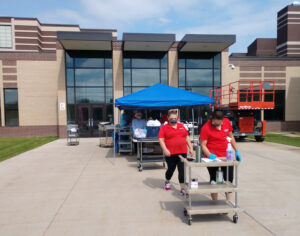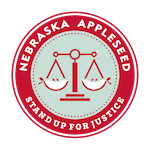How School Meal Service has Changed During COVID-19
This is a guest blog post by Libby Israel, Nebraska Appleseed’s Youth Ambassador for Food and Nutrition Access.

It has been nearly a full year since child nutrition programs across the country were turned upside down by the COVID-19 pandemic. Facing safety-related closures, added risk, and remote learning models, nutrition directors have had to adapt their programs to a new normal.

Waivers granted by Congress and the United States Department of Agriculture (USDA) in March of 2020 enabled changes to traditional service models. For in-person learners, lunchrooms have been expanded into gyms and outdoor areas, and self-service has been nearly eliminated in favor of individually packaged foods. Similarly, hand sanitizing stations, sneeze guards, and single-use plastics have become common practice.
For remote learners, meal service has been accomplished using drive-thru, curbside pickup, walk-up distribution models, and mobile or bus route delivery, with extended meal pickup times and staggered meal service to ensure that all students have the ability to receive meals safely.
The chart below outlines answers to common questions about COVID-19 schools meal service programs currently in use:
Frequently Asked Questions about COVID-19 Meal Service Changes
| Pre-Pandemic | Now | |
| What do school meals cost? | Meals served during the school year are priced based on family income (free, reduced-price, and paid). | Meals are temporarily free statewide through the Summer Food Service Program. |
| Where do students eat? | Students eat together in the school. | Students or parents can use grab and go models, curbside pickup, home delivery or mobile bus routes to deliver or distribute food. |
| How many meals can be distributed at once? | Meals must be served at specific times, with one meal per individual. | In-person students are served similar to pre-pandemic. Remote students are served up to 7 days worth of meals in a single pickup, delivery or drop off, with potentially breakfast, lunch, supper, and snack included each day. |
| Who can pick up remote meals? | Meals must be served directly to the child. | Parents or guardians can pick up meals for their child(ren) without them present. |
| Service style for in-person students? | Breakfast can be served out of the cafeteria, via grab and go, or after the first period. Lunch is in the cafeteria. | All models limit groups and exposure to multiple groups of people. Expanded eating spaces (such as in classrooms or gyms), plexiglass barriers, no buffets, individually portioned food items. |
| Are meals still balanced and healthy? | Yes! All meal components must follow strict health guidelines and make up a balanced meal. | Yes! Same as pre-pandemic. |
We encourage you to check with your local school district to find out more about the changes they have made because of COVID-19 since every district has the flexibility to do what works best for them within the waivers.
The hard work of nutrition administrators, directors, and staff during the pandemic has hopefully highlighted the essential nature of school nutrition programs and the people who make them run. We invite you to join us in thanking these individuals for their continued efforts and dedication to their students!

